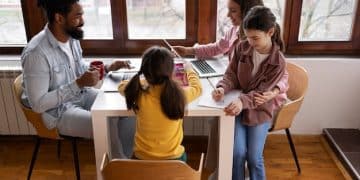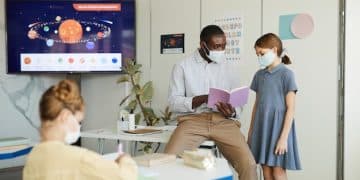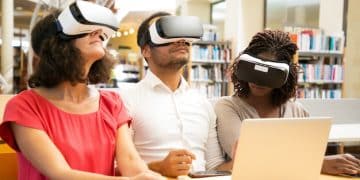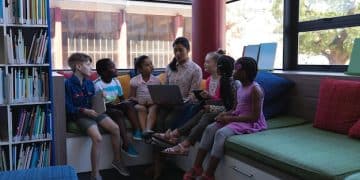Effective Strategies for Promoting Cultural Understanding in US Schools
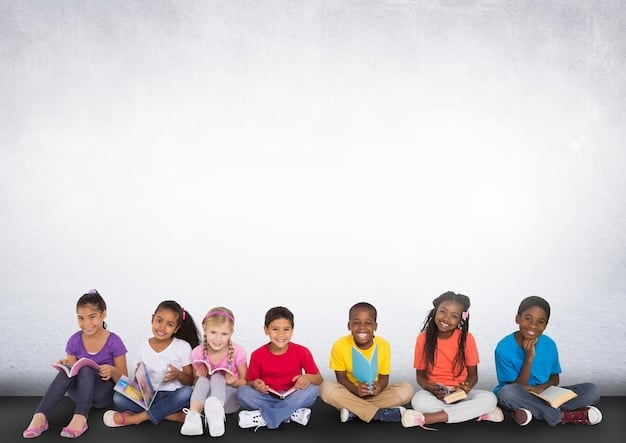
Effective strategies for promoting cultural understanding in US schools include implementing inclusive curriculum, fostering diverse extracurricular activities, providing professional development for teachers, and encouraging community engagement.
In today’s increasingly diverse society, **what are the most effective strategies for promoting cultural understanding in US schools?** Understanding and appreciating different cultures are essential for students to thrive in a globalized world.
Creating Inclusive Curriculum in US Schools
An inclusive curriculum is the foundation for fostering cultural understanding. It ensures that students learn about a wide range of cultures, histories, and perspectives, rather than focusing solely on the dominant culture.
By integrating diverse voices and experiences into the curriculum, schools can help students develop empathy and respect for others.
Incorporating Diverse Perspectives
To create a truly inclusive curriculum, it is essential to incorporate diverse perspectives into every subject. This means going beyond superficial representations and delving into the complexities of different cultures.
Integrating Multicultural Literature
Literature is a powerful tool for promoting cultural understanding. Schools should prioritize the inclusion of multicultural literature that reflects the experiences of diverse communities.
- Selecting Authentic Voices: Prioritize books written by authors from the cultures they are depicting.
- Analyzing Cultural Themes: Encourage students to critically analyze cultural themes and stereotypes presented in literature.
- Promoting Discussion: Facilitate class discussions that explore the nuances of different cultural perspectives.
- Showcasing Various Genres: Include a variety of genres, such as novels, poems, and biographies, to expose students to diverse literary styles and cultural expressions.
Incorporating diverse perspectives and multicultural literature can transform the learning environment and foster a deeper appreciation for cultural diversity.
Fostering Diverse Extracurricular Activities
Extracurricular activities play a crucial role in promoting cultural understanding by providing students with opportunities to interact with peers from different backgrounds and engage in culturally relevant activities.
Schools can create a more inclusive environment by offering a wide range of extracurricular activities that celebrate diversity and encourage cross-cultural interaction.

Establishing Cultural Clubs
Cultural clubs provide a platform for students to learn about and celebrate their own cultures, as well as the cultures of others. These clubs can organize events, workshops, and performances that showcase the diversity of the student body.
Organizing International Celebrations
Schools can organize international celebrations that showcase the diverse cultures represented in the student body. These events can include cultural performances, food festivals, and art exhibitions.
- Involving Student Leaders: Empower student leaders to take ownership of organizing and promoting international celebrations.
- Engaging Community Members: Invite community members from different cultural backgrounds to participate in the celebrations.
- Showcasing Diverse Traditions: Highlight the unique traditions, customs, and art forms of different cultures.
- Promoting Interactive Activities: Incorporate interactive activities, such as language lessons, dance workshops, and cooking demonstrations, to engage students and promote cultural exchange.
By establishing cultural clubs and organizing international celebrations, schools can create a vibrant and inclusive environment that celebrates diversity and promotes cultural understanding.
Providing Professional Development for Teachers
Teachers play a critical role in promoting cultural understanding in the classroom. To effectively address diversity and create an inclusive learning environment, teachers need access to ongoing professional development opportunities.
These professional development programs should focus on cultural competency, bias awareness, and culturally responsive teaching strategies.
Cultural Competency Training
Cultural competency training equips teachers with the knowledge, skills, and attitudes necessary to effectively interact with students from diverse cultural backgrounds. This training can help teachers understand their own cultural biases and develop strategies for creating a more inclusive classroom.
Bias Awareness Workshops
Bias awareness workshops help teachers identify and address their own implicit biases, which can unconsciously influence their interactions with students. By becoming aware of their biases, teachers can work to create a more equitable learning environment for all students.
Providing professional development for teachers is an investment in creating a more culturally inclusive and equitable learning environment for all students.
Encouraging Community Engagement
Community engagement is an essential component of promoting cultural understanding in schools. By partnering with local organizations and community members, schools can create opportunities for students to learn about different cultures and engage in meaningful cross-cultural interactions.
This type of engagement can take many forms, from inviting guest speakers to organizing community service projects.
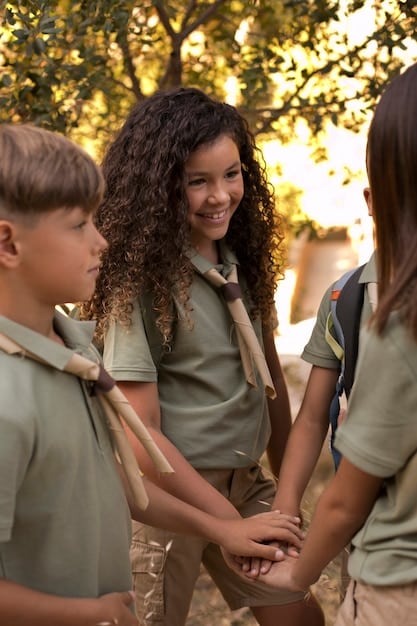
Partnering with Local Organizations
Schools can partner with local organizations that serve diverse communities to provide students with opportunities to learn about different cultures and engage in community service. These partnerships can also help to bridge the gap between the school and the community.
Inviting Guest Speakers
Inviting guest speakers from diverse cultural backgrounds can provide students with firsthand perspectives and insights. These speakers can share their experiences, stories, and cultural traditions, helping students to develop a deeper understanding and appreciation for different cultures.
- Identifying Diverse Voices: Reach out to community leaders, artists, activists, and professionals from diverse backgrounds to serve as guest speakers.
- Preparing Students with Background Information: Provide students with background information about the speaker and their cultural background to help them engage in meaningful dialogue.
- Facilitating Q&A Sessions: Encourage students to ask questions and engage in open, respectful dialogue with the guest speaker.
- Reflecting on Key Takeaways: After the presentation, facilitate a class discussion to reflect on key takeaways and encourage students to share their perspectives.
Engaging with the community provides students with invaluable opportunities to learn about different cultures, challenge their own assumptions, and develop a sense of global citizenship.
Implementing Culturally Responsive Teaching Strategies
Culturally responsive teaching (CRT) is an approach to instruction that recognizes and values the cultural backgrounds of all students. It involves adapting teaching methods, materials, and assessments to align with students’ cultural experiences and learning styles.
CRT is not simply about adding cultural content to the curriculum; it is about transforming the entire learning environment to be more inclusive and equitable.
Creating a Culturally Inclusive Classroom Environment
Creating a culturally inclusive classroom environment involves celebrating diversity, promoting respect, and fostering a sense of belonging for all students. This can be achieved through a variety of strategies, such as displaying multicultural artwork, incorporating diverse perspectives into lessons, and establishing classroom norms that value cultural differences.
Adapting Teaching Methods
Adapting teaching methods to align with students’ cultural learning styles is another key component of CRT. This may involve incorporating visual aids, hands-on activities, or group work to accommodate different learning preferences.
Implementing culturally responsive teaching strategies is essential for creating a learning environment that is equitable, inclusive, and empowering for all students.
Assessing and Evaluating Cultural Understanding
Assessing cultural understanding is a crucial step in evaluating the effectiveness of strategies aimed at promoting diversity and inclusivity in US schools.
Such assessments should go beyond rote memorization and aim to gauge students’ abilities to empathize, critically analyze cultural perspectives, and apply their knowledge in real-world scenarios.
Employing Diverse Assessment Methods
Opt for varied assessment approaches like project-based assignments, presentations, and group discussions to truly measure students’ cultural understanding.
Incorporating Self-Reflection
Inspire students to engage in introspection concerning their own cultural biases and perceptions. This can be achieved through written reflections or facilitated conversations, enabling them to think critically about cultural diversity.
- Prompting Self-Awareness: Utilize prompts that encourage students to reflect on their own cultural identities, values, and assumptions.
- Promoting Open Dialogue: Cultivate a safe space where students feel empowered to share their perspectives without fear of judgment.
- Providing Constructive Feedback: Offer encouragement for students to delve deeper into their self-awareness and identify possible growth areas.
- Fostering Empathy: Steer learners toward recognizing and valuing different perspectives.
Through thoughtful assessment and evaluation, schools can gain valuable insights into the efficacy of their cultural understanding initiatives, fine-tuning strategies to better resonate with the needs of their students.
| Key Point | Brief Description |
|---|---|
| 📚 Inclusive Curriculum | Integrate diverse voices and multicultural literature into all subjects. |
| 🎉 Diverse Activities | Offer cultural clubs and international celebrations. |
| 👩🏫 Teacher Training | Provide development in cultural competency and bias awareness. |
| 🤝 Community Engagement | Partner with local organizations and invite guest speakers. |
Frequently Asked Questions
▼
Cultural understanding is crucial because it promotes empathy, reduces prejudice, and prepares students for a diverse world. It enriches learning experiences and fosters inclusive environments.
▼
Schools can create inclusivity by diversifying curricula, supporting cultural clubs, and providing bias training. Celebrating different cultural events and traditions also promotes inclusiveness.
▼
Teachers play a vital role by implementing culturally responsive teaching strategies. These strategies adapt instruction to incorporate diverse cultural backgrounds, experiences, and learning styles.
▼
Community involvement enhances cultural understanding by providing real-world exposure and interactions. Partnerships with local groups, guest speakers, and service projects facilitate this exposure.
▼
Assess cultural understanding with project-based assignments, group discussions, and reflective writing. This gauges empathy and critical analysis of cultural perspectives effectively.
Conclusion
Promoting cultural understanding in US schools requires a multifaceted approach, including inclusive curricula, diverse activities, professional development for teachers, community engagement, and culturally responsive teaching strategies. By embracing these strategies, schools can cultivate environments where students thrive in an interconnected world.

